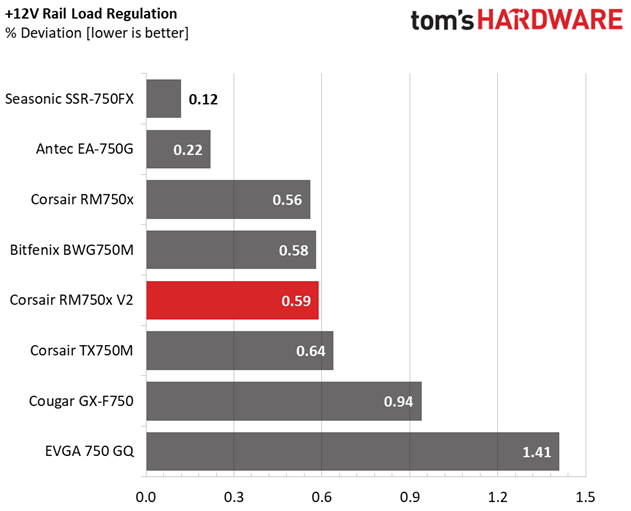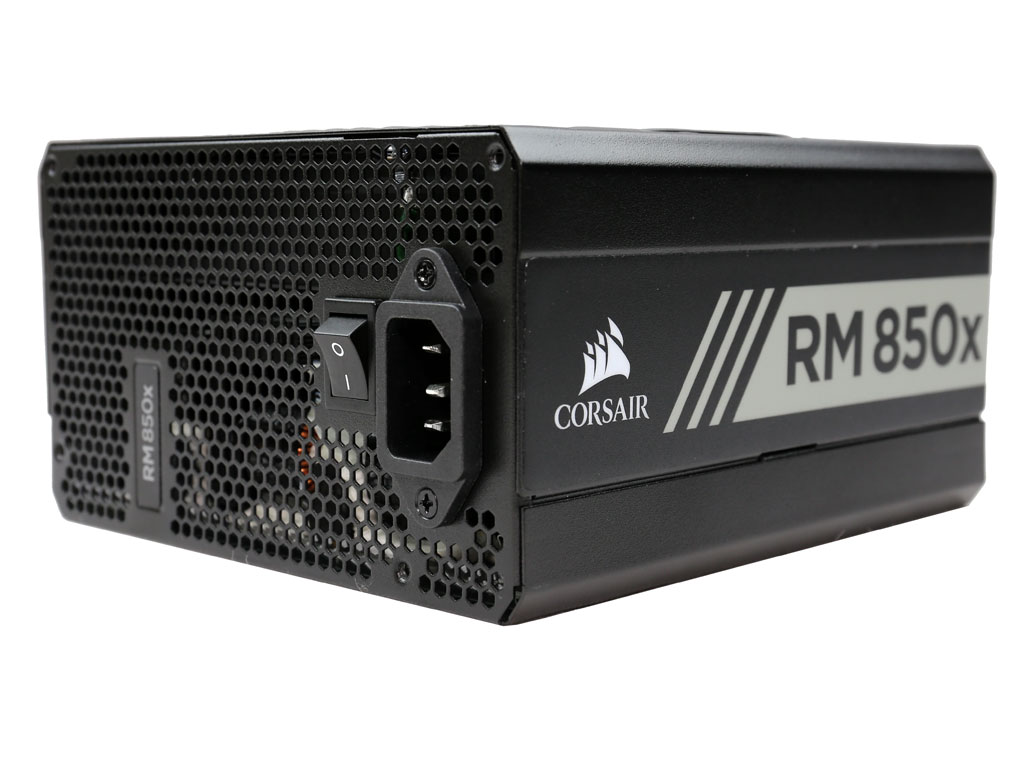Corsair RM750x PSU Review: Improving On A Classic
Why you can trust Tom's Hardware
Load Regulation, Hold-Up Time & Inrush Current
To learn more about our PSU tests and methodology, please check out How We Test Power Supply Units.
Primary Rails And 5VSB Load Regulation
Load Regulation testing is detailed here.








Hold-Up Time
Our hold-up time tests are described in detail here.







The hold-up time we measured was much longer than 17ms, and the power-good signal was accurate.
Inrush Current
For details on our inrush current testing, please click here.


Observed inrush current was low with both voltage inputs.
Load Regulation And Efficiency Measurements
The first set of tests reveals the stability of the voltage rails and the RM750x’s efficiency. The applied load equals (approximately) 10 to 110 percent of the PSU's maximum load in increments of 10 percentage points.
Get Tom's Hardware's best news and in-depth reviews, straight to your inbox.
We conducted two additional tests. During the first, we stressed the two minor rails (5V and 3.3V) with a high load, while the load at +12V was only 0.1A. This test reveals whether a PSU is compatible with Intel's C6/C7 sleep states or not. In the second test, we determined the maximum load the +12V rail could handle with minimal load on the minor rails.
| Test # | 12V | 5V | 3.3V | 5VSB | DC/AC (Watts) | Efficiency | Fan Speed | PSU Noise | Temps (In/Out) | PF/AC Volts |
|---|---|---|---|---|---|---|---|---|---|---|
| 1 | 4.364A | 1.984A | 1.999A | 0.997A | 74.792 | 85.255% | 0 RPM | <6.0 dB(A) | 48.26°C | 0.975 |
| 12.194V | 5.032V | 3.302V | 5.009V | 87.727 | 38.21°C | 115.07V | ||||
| 2 | 9.760A | 2.979A | 2.999A | 1.196A | 149.795 | 89.711% | 0 RPM | <6.0 dB(A) | 48.86°C | 0.989 |
| 12.186V | 5.030V | 3.298V | 5.004V | 166.975 | 38.56°C | 115.07V | ||||
| 3 | 15.501A | 3.486A | 3.516A | 1.401A | 224.926 | 90.670% | 610 RPM | 10.2 dB(A) | 39.44°C | 0.993 |
| 12.181V | 5.026V | 3.296V | 4.996V | 248.071 | 50.36°C | 115.07V | ||||
| 4 | 21.245A | 3.983A | 4.003A | 1.601A | 299.797 | 91.050% | 610 RPM | 10.2 dB(A) | 40.29°C | 0.993 |
| 12.173V | 5.023V | 3.294V | 4.990V | 329.266 | 51.56°C | 115.07V | ||||
| 5 | 26.662A | 4.977A | 5.007A | 1.804A | 374.803 | 90.801% | 610 RPM | 10.2 dB(A) | 41.59°C | 0.991 |
| 12.165V | 5.020V | 3.292V | 4.985V | 412.772 | 53.32°C | 115.07V | ||||
| 6 | 32.076A | 5.976A | 6.018A | 2.006A | 449.686 | 90.349% | 610 RPM | 10.2 dB(A) | 42.31°C | 0.992 |
| 12.156V | 5.019V | 3.288V | 4.980V | 497.719 | 54.71°C | 115.07V | ||||
| 7 | 37.502A | 6.982A | 7.026A | 2.209A | 524.687 | 89.778% | 610 RPM | 10.2 dB(A) | 42.88°C | 0.993 |
| 12.148V | 5.017V | 3.287V | 4.975V | 584.426 | 56.06°C | 115.07V | ||||
| 8 | 42.937A | 7.975A | 8.037A | 2.411A | 599.626 | 89.081% | 714 RPM | 16.5 dB(A) | 43.85°C | 0.994 |
| 12.140V | 5.015V | 3.284V | 4.970V | 673.127 | 57.72°C | 115.06V | ||||
| 9 | 48.801A | 8.480A | 8.560A | 2.412A | 674.645 | 88.343% | 888 RPM | 22.7 dB(A) | 44.75°C | 0.995 |
| 12.132V | 5.013V | 3.282V | 4.970V | 763.667 | 58.88°C | 115.07V | ||||
| 10 | 54.422A | 8.987A | 9.057A | 3.028A | 749.582 | 87.520% | 1119 RPM | 30.0 dB(A) | 45.99°C | 0.995 |
| 12.125V | 5.010V | 3.279V | 4.951V | 856.468 | 60.59°C | 115.07V | ||||
| 11 | 60.639A | 8.994A | 9.062A | 3.030A | 824.436 | 86.724% | 1310 RPM | 34.8 dB(A) | 46.76°C | 0.996 |
| 12.116V | 5.009V | 3.276V | 4.949V | 950.646 | 61.71°C | 115.07V | ||||
| CL1 | 0.100A | 18.029A | 18.002A | 0.005A | 151.027 | 81.669% | 785 RPM | 18.1 dB(A) | 42.71°C | 0.992 |
| 12.165V | 5.021V | 3.292V | 5.071V | 184.926 | 55.50°C | 115.09V | ||||
| CL2 | 62.457A | 1.002A | 1.003A | 1.002A | 771.046 | 88.047% | 1116 RPM | 29.7 dB(A) | 44.99°C | 0.995 |
| 12.132V | 5.014V | 3.284V | 4.990V | 875.718 | 58.77°C | 115.08V |
The RM750x's load regulation at +12V wasn't as tight as Seasonic's SSR-750FX, but it still landed within 0.6%. The minor rails performed equally well. And the 5VSB rail stayed within 2%, so it easily took the lead from the SSR-750FX.
The RM750x satisfied all 80 PLUS Gold requirements, despite the increased temperatures that we applied. At the same time, its fan spun slowly up through the ninth test. Even during our full load and overload tests, the PSU remained quiet. For comparison, the SSR-750FX under full load at 46°C generated 45.2 dB(A), while the RM750x was at 30 dB(A). That difference is huge; for every 3 dB(A), the sound intensity or acoustic power doubles. Meanwhile, the perceived volume (relative loudness) doubles for most of us with every 10 dB(A) increase. To be sure, the RM750x is one of the quietest 750W PSUs available. The best part is that this generalization still applies under highly stressful environmental conditions.
MORE: Best Power Supplies
MORE: How We Test Power Supplies
MORE: All Power Supply Content
Current page: Load Regulation, Hold-Up Time & Inrush Current
Prev Page Teardown & Component Analysis Next Page Efficiency, Temperature & Noise
Aris Mpitziopoulos is a contributing editor at Tom's Hardware, covering PSUs.
-
joedavies87 I bought one last year and did not realize that I would need two EPS cables for future builds. Moved to EVGA. Corsair was too late.Reply


